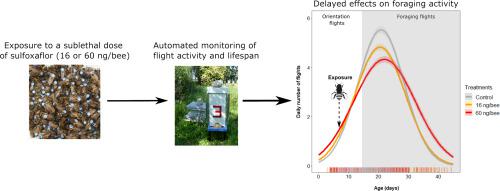Science of the Total Environment ( IF 8.2 ) Pub Date : 2021-09-16 , DOI: 10.1016/j.scitotenv.2021.150351 Lena Barascou 1 , Fabrice Requier 2 , Deborah Sené 1 , Didier Crauser 1 , Yves Le Conte 1 , Cedric Alaux 1

|
Pesticide risk-assessment guidelines for honeybees (Apis mellifera) generally require determining the acute toxicity of a chemical over the short-term through fix-duration tests. However, potential long-lasting or delayed effects resulting from an acute exposure (e.g. a single dose) are often overlooked, although the modification of a developmental process may have life-long consequences. To investigate this question, we exposed young honeybee workers to a single sublethal field-realistic dose of a neurotoxic pesticide, sulfoxaflor, at one of two amounts (16 or 60 ng), at the moment when they initiated orientation flights (preceding foraging activity). We then tracked in the field their flight activity and lifespan with automated life-long monitoring devices. Both amounts of sulfoxaflor administered reduced the total number of flights but did not affect bee survival and flight duration. When looking at the time series of flight activity, effects were not immediate but delayed until foraging activity with a decrease in the daily number of foraging flights and consequently in their total number (24 and 33% less for the 16 and 60 ng doses, respectively). The results of our study therefore blur the general assumption in honeybee toxicology that acute exposure results in immediate and rapid effects and call for long-term recording and/or time-to-effect measurements, even upon exposure to a single dose of pesticide.
中文翻译:

单剂量的神经毒性农药(氟啶虫胺)对蜜蜂觅食活动的延迟影响
蜜蜂(Apis mellifera)农药风险评估指南) 通常需要通过固定持续时间测试来确定化学品在短期内的急性毒性。然而,尽管发育过程的改变可能会产生终生后果,但由于急性暴露(例如单次剂量)导致的潜在长期或延迟影响往往被忽视。为了研究这个问题,我们让年轻的蜜蜂工人在他们开始定向飞行(觅食活动之前)的那一刻,让他们接触一种亚致死量的现场现实剂量的神经毒性杀虫剂磺胺嘧啶,两种剂量之一(16 或 60 ng) . 然后,我们使用自动终身监控设备在现场跟踪他们的飞行活动和寿命。两种剂量的氟啶虫胺都减少了总飞行次数,但不影响蜜蜂的存活率和飞行持续时间。在观察飞行活动的时间序列时,影响不会立即发生,而是延迟到觅食活动,随着每日觅食飞行次数的减少,它们的总数减少(16 和 60 ng 剂量分别减少 24% 和 33%) )。因此,我们的研究结果模糊了蜜蜂毒理学中的一般假设,即急性暴露会导致立即和快速的影响,并且需要长期记录和/或生效时间测量,即使是在暴露于单剂量杀虫剂的情况下。











































 京公网安备 11010802027423号
京公网安备 11010802027423号